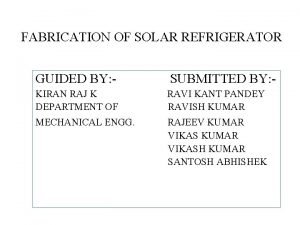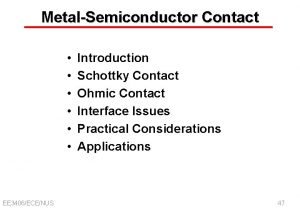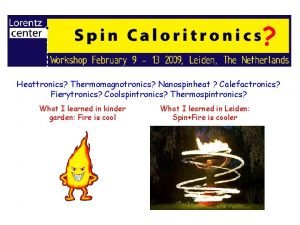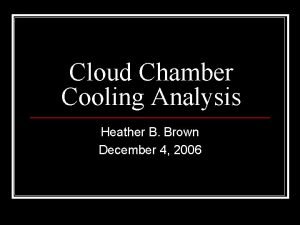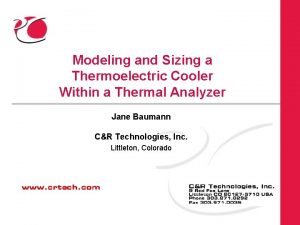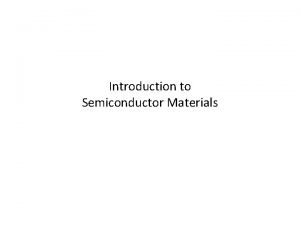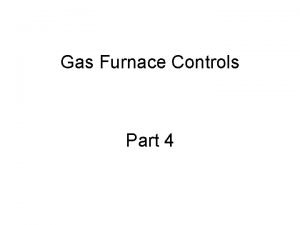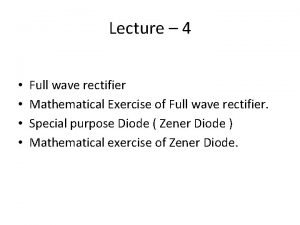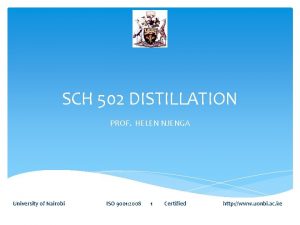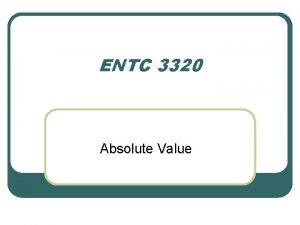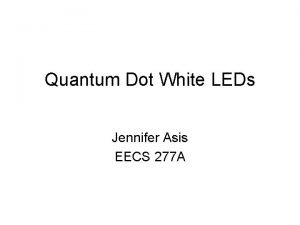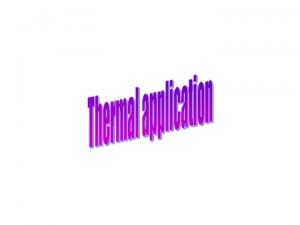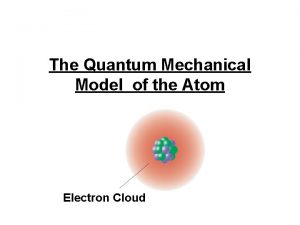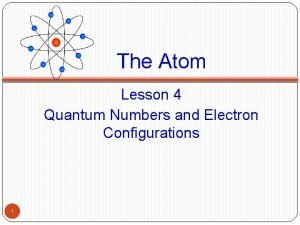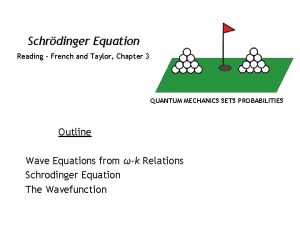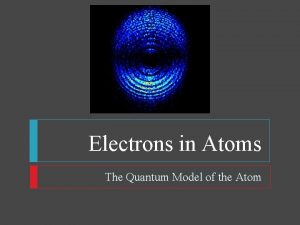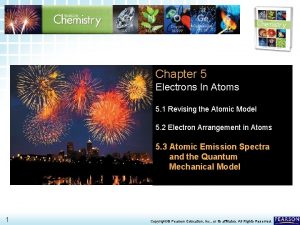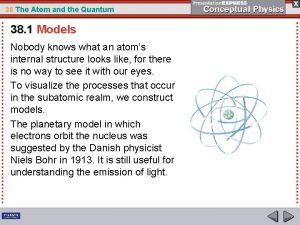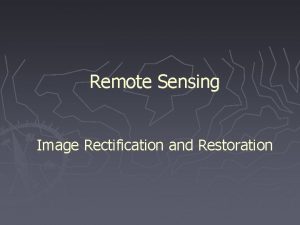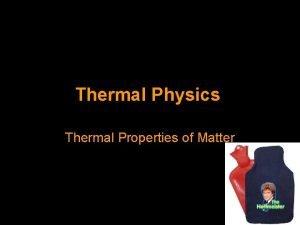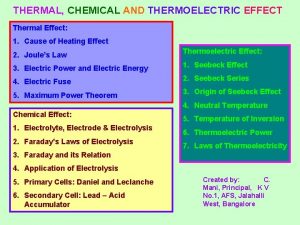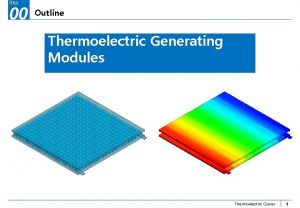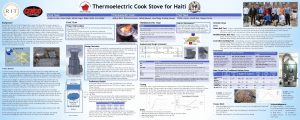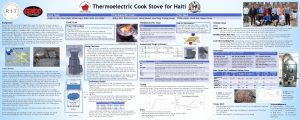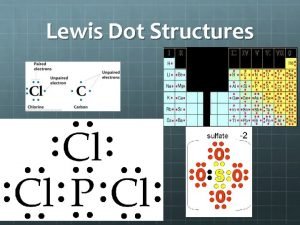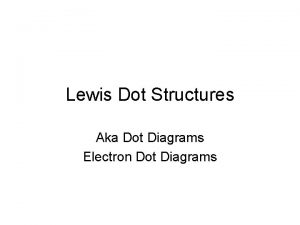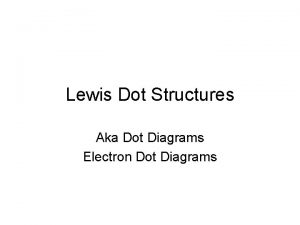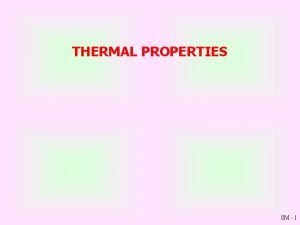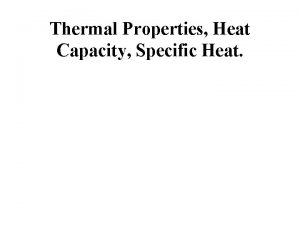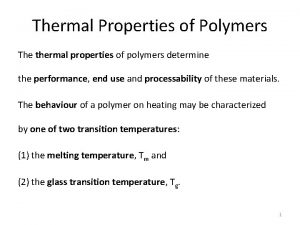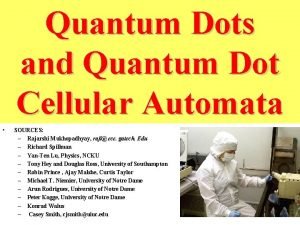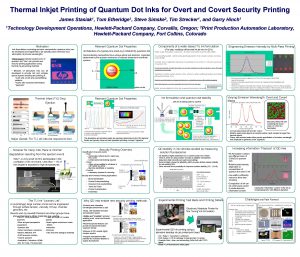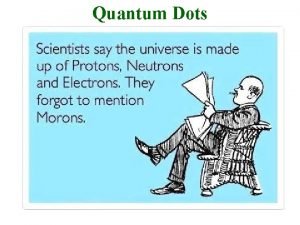Thermoelectric and thermal rectification properties of quantum dot


![References • [1]A. J. Minnich, M. S. Dresselhaus, Z. F. Ren and G. Chen, References • [1]A. J. Minnich, M. S. Dresselhaus, Z. F. Ren and G. Chen,](https://slidetodoc.com/presentation_image_h2/742c82ce4a43339a7bb3a00d9dd24120/image-3.jpg)



![1 -2: Nonequilibrium Green’s function technique Ref[1]D. M. T. Kuo and Y. C. Chang, 1 -2: Nonequilibrium Green’s function technique Ref[1]D. M. T. Kuo and Y. C. Chang,](https://slidetodoc.com/presentation_image_h2/742c82ce4a43339a7bb3a00d9dd24120/image-7.jpg)











![3 -2: Thermal rectification efficiency (2 dots) TL TR Ref[4] R. Scheiber et al, 3 -2: Thermal rectification efficiency (2 dots) TL TR Ref[4] R. Scheiber et al,](https://slidetodoc.com/presentation_image_h2/742c82ce4a43339a7bb3a00d9dd24120/image-19.jpg)




![4: Conclusion (A) Figure of merit, ZT [1]The optimization of ZT depends not only 4: Conclusion (A) Figure of merit, ZT [1]The optimization of ZT depends not only](https://slidetodoc.com/presentation_image_h2/742c82ce4a43339a7bb3a00d9dd24120/image-24.jpg)
















- Slides: 40

Thermoelectric and thermal rectification properties of quantum dot junctions David M T Kuo 1 and Yia-Chung Chang 2 1: Department of Electrical Engineering, National Central University, Taiwan 2: Research Center for Applied Science, Academic Sinica, Taiwan The detail can be found in PRB 81, 205321 (2010)

Urbana-2003 -July
![References 1A J Minnich M S Dresselhaus Z F Ren and G Chen References • [1]A. J. Minnich, M. S. Dresselhaus, Z. F. Ren and G. Chen,](https://slidetodoc.com/presentation_image_h2/742c82ce4a43339a7bb3a00d9dd24120/image-3.jpg)
References • [1]A. J. Minnich, M. S. Dresselhaus, Z. F. Ren and G. Chen, Energy Environ Science, 2, 466 (2009) • [2]G. Mahan, B. Sales and J. Sharp, Physics Today, 50, 42 (1997). • [3]R. Venkatasubramanian, E. Siivola, T. Colpitts, B. O'Quinn, Nature 413, 597 (2001). ”Bi. Te/Sb. Te quantum well superlattice” • [4]A. I. Boukai, Y. Bunimovich, J. Tahir-Kheli, J. K. Yu, W. A. Goddard III and J. R. Heath, Nature, 451, 168(2008). ”Silicon quantum wire” • [5]T. C. Harman, P. J. Taylor, M. P. Walsh, B. E. La. Forge, Science 297, 2229 (2002). ”Pb. Se. Te Quantum dot superlattice “ • [6]K. F. Hsu, S. Loo, F. Guo, W. Chen, J. S. Dyck, C. Uher, T. Hogan, E. K. Polychroniadis, M. G. Kanatzidis, Science 303, 818(2004) • . [7]A. Majumdar, Science 303, 777 (2004). • [8]G. Chen, M. S. Dresselhaus, G. Dresselhaus, J. P. Fleurial and T. Caillat, International Materials Reviews, 48, 45 (2003) • [9]Y. M. Lin and M. S. Dresselhaus, Phys. Rev. B 68, 075304 (2003).

1: System Amorphous insulator Large intradot and interdot Coulomb interactions

1 -0: Fabrication

1 -1: Hamiltonian (Anderson model) The key effects included are the intradot and interdot Coulomb interactions and the coupling between the QDs with the metallic leads There is one energy level within each QD
![1 2 Nonequilibrium Greens function technique Ref1D M T Kuo and Y C Chang 1 -2: Nonequilibrium Green’s function technique Ref[1]D. M. T. Kuo and Y. C. Chang,](https://slidetodoc.com/presentation_image_h2/742c82ce4a43339a7bb3a00d9dd24120/image-7.jpg)
1 -2: Nonequilibrium Green’s function technique Ref[1]D. M. T. Kuo and Y. C. Chang, Phys. Rev. Lett. 99, 086803(2007) Ref[2]Y. C. Chang and D. M. T Kuo, Phys. Rev. B 77, 245412 (2008)

2: Linear response Homogenous QD size, dilute QD density Eg EF ZT as a function of T for different detuning energies. Solid and dash lines correspond, respectively, without and with intradot Coulomb interactions. Ref[3]P. Murphy, S. Mukerjee, J. Morre, Phys. Rev. B 78, 161406 (2008).

2 -1: Interdot Coulomb interactions High QD density Side view (a) (b) (c ) (d) (a) Top view (b) (c) (d)

2 -2: ZT detuned by Eg Noninteraction case High QD density EF Eg

2 -3: Inelastic scattering effect on ZT QD size fluctuations, defects between metallic electrodes and insulators and electron-phonon interactions,

2 -4: Electrical conductance, thermal power and thermal conductance These curves correspond to Fig. 3. The temperature-dependence of ZT is similar to that of the electrical conductivity.

2 -5: Ge, S and Ke as a function of gate voltage Ge: Coulomb oscillation S: Sawtooth-like shape Ke: Sensitive to T

2 -6: Midway between the good and poor conductors

2. 7 Without vacuum layer

2. 8 Different dot sizes 2 nm

2. 9 Thickness of Si. O 2

3 -1: Thermal rectification effect Two dot case TL TR
![3 2 Thermal rectification efficiency 2 dots TL TR Ref4 R Scheiber et al 3 -2: Thermal rectification efficiency (2 dots) TL TR Ref[4] R. Scheiber et al,](https://slidetodoc.com/presentation_image_h2/742c82ce4a43339a7bb3a00d9dd24120/image-19.jpg)
3 -2: Thermal rectification efficiency (2 dots) TL TR Ref[4] R. Scheiber et al, New. J. Phys. 10, 083016 (2008)

3 -3: Thermal rectification (three QDs) Dot A

3 -4: The shift of QD energy levels caused by electrochemical potential Solid curves including Dashed curves excluding TL VH TH VL TH TL VL VH

3 -5: Interdot Coulomb interactions Solid line UAC=15 k. BT 0 Dashed line UAC=10 k. BT 0 Dotted line UAC=5 k. BT 0 Dot-Dashed line UAC=0

3 -6: Thermal rectification efficiency 3 dots 2 dots
![4 Conclusion A Figure of merit ZT 1The optimization of ZT depends not only 4: Conclusion (A) Figure of merit, ZT [1]The optimization of ZT depends not only](https://slidetodoc.com/presentation_image_h2/742c82ce4a43339a7bb3a00d9dd24120/image-24.jpg)
4: Conclusion (A) Figure of merit, ZT [1]The optimization of ZT depends not only on the temperature but also on the detuning energy [2]Inelastic scattering effect of electron-phonon interactions, QD size fluctuations, and defects lead to a considerable reduction to the ZT values (B)Thermal rectification [1] Very strong asymmetrical coupling between the dots and the electrodes. [2] Large energy level separation between dots [3]Strong interdot Coulomb interactions

4. Thermal rectification

4. 1 Tunneling rates TH TL

4. 2 Tuning energy level

4. 3 Three-dots with uniform size The dot-dashed line indicates the junction system without asymmetrical heat current, when dots are identical.

4. 4: Different sizes

4. 5 : Gate voltage

4. 6: Interdot Coulomb interactions

4. 7: Energy level shifted by electrochemical potential

5: A single molecular QD (a)Hard to scaling up thermal devices. (b)Hard to integrate with silicon based electronics. [1]P. Murphy, S. Mukerjee and J. Morre, Phys. Rev. B 78, 161406 (2008).

5. 1:

5. 2: Detuning energy

5. 3:

5. 4

5. 5

5. 6:

5. 7: S to resolve high order phonon assisted tunneling
 Id root
Id root Guided by and submitted by
Guided by and submitted by Thermoelectric cooler
Thermoelectric cooler Sxy prb
Sxy prb Incopetency
Incopetency Melcor tec
Melcor tec Piv of centre tapped rectifier
Piv of centre tapped rectifier Shelf rectification and stock verification
Shelf rectification and stock verification Quantum physics vs quantum mechanics
Quantum physics vs quantum mechanics Quantum physics vs mechanics
Quantum physics vs mechanics Thermal energy section 3
Thermal energy section 3 Thermal transfer vs direct thermal printing
Thermal transfer vs direct thermal printing 1-5 solving inequalities
1-5 solving inequalities Advantages of full wave rectifier
Advantages of full wave rectifier Rectification formula
Rectification formula Standing pilot furnace sequence of operation
Standing pilot furnace sequence of operation Flame rectification circuit
Flame rectification circuit Full wave rectification
Full wave rectification Rectification using a partially vaporized feed
Rectification using a partially vaporized feed Absolute value circuit
Absolute value circuit D'arsonval meter movement used with full-wave rectification
D'arsonval meter movement used with full-wave rectification Quantum dot led
Quantum dot led Quantum dot ppt
Quantum dot ppt Mechanical behavior of materials
Mechanical behavior of materials .net vs java
.net vs java Thermal properties of dental materials
Thermal properties of dental materials Thermal properties of frozen foods
Thermal properties of frozen foods Perspective geometry
Perspective geometry Extensive and intensive properties
Extensive and intensive properties Is smell a physical property
Is smell a physical property Quantum and nuclear physics
Quantum and nuclear physics Quantum mechanical model atom
Quantum mechanical model atom Quantum numbers and electron configuration
Quantum numbers and electron configuration French and taylor quantum mechanics
French and taylor quantum mechanics Nuclear and quantum engineering
Nuclear and quantum engineering Compare and contrast bohr model to quantum model
Compare and contrast bohr model to quantum model Alice and bob in wonderland
Alice and bob in wonderland Atomic emission spectra and the quantum mechanical model
Atomic emission spectra and the quantum mechanical model Chapter 38 the atom and the quantum
Chapter 38 the atom and the quantum Lowest allowable energy state of an atom
Lowest allowable energy state of an atom Quantum computing progress and prospects
Quantum computing progress and prospects

